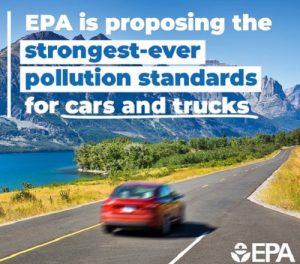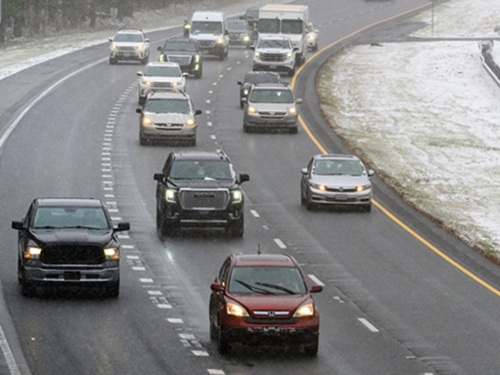The U.S. Environmental Protection Agency recently proposed a stringent set of federal vehicle emissions standards to, in its words, “accelerate the ongoing transition to a clean vehicles future and tackle the climate crisis.”
[Above image of EPA headquarters via the EPA]
“By proposing the most ambitious pollution standards ever for cars and trucks, we are delivering on the … promise to protect people and the planet, securing critical reductions in dangerous air and climate pollution and ensuring significant economic benefits like lower fuel and maintenance costs for families,” said EPA Administrator Michael Regan in a statement, adding that those “ambitious standards” should help drive “historic progress” to build more American-made electric cars.

The first set of proposed standards covers model year or MY 2027 and later light- and medium duty vehicles and builds on EPA’s existing emissions standards for passenger cars and light trucks for MY 2023 through 2026. The proposal retains the proven regulatory design of previous EPA standards for light-duty vehicles, but “leverages advances in clean car technology” to further reduce both climate pollution and smog- and soot-forming emissions, the agency said.
Between 2027 and 2055, the total projected net benefits of the light- and medium-duty proposal range from $850 billion to $1.6 trillion. The proposal is expected to avoid 7.3 billion tons of carbon dioxide or CO2 emissions through 2055, equivalent to eliminating all greenhouse gas emissions from the entire current U.S. transportation sector for four years.
The agency also claimed that those new standards would also “deliver significant health benefits” by reducing fine particulate matter that can cause premature death, heart attacks, respiratory and cardiovascular illnesses, aggravated asthma, and decreased lung function.
EPA added that its proposal considers a “broad suite” of available emission control technologies, and the standards are designed to allow manufacturers to meet the performance-based standards however works best for their vehicle fleets. EPA projects that for the industry as a whole, the standards are expected to drive widespread use of filters to reduce gasoline particulate matter emissions and spur greater deployment of CO2-reducing technologies for gasoline-powered vehicles.
Those light- and medium-duty vehicle proposed standards are also projected to accelerate the transition to electric vehicles or EVs, EPA noted. Depending on the compliance pathways manufacturers select to meet the standards, EPA projects that EVs could account for 67 percent of new light-duty vehicle sales and 46 percent of new medium-duty vehicle sales in MY 2032.

The second set of proposed standards regards “phase three” greenhouse gas or GHG standards for heavy-duty vehicles and would apply to heavy-duty vocational vehicles – such as delivery trucks, refuse haulers or dump trucks, public utility trucks, transit, shuttle, and school buses – as well as trucks typically used to haul freight. Those standards would complement the criteria pollutant standards for MY 2027 and beyond heavy-duty vehicles that EPA finalized in December 2022 and represent the third phase of EPA’s Clean Trucks Plan.
These “Phase 3” greenhouse gas standards maintain the flexible structure that EPA previously designed through a robust stakeholder engagement process to reflect the diverse nature of the heavy-duty industry. Like the light- and medium-duty proposal, the heavy-duty proposal uses performance-based standards that enable manufacturers to achieve compliance efficiently based on the composition of their fleets, EPA said, with the agency claiming projected net benefits from its the heavy-duty GHG emission reduction proposal ranging from $180 billion to $320 billion.
The proposal is projected to avoid 1.8 billion tons of CO2 through 2055, equivalent to eliminating all greenhouse gas emissions from the entire current U.S. transportation sector for an entire year, and deliver additional health benefits by reducing other pollutants from these vehicles.
The standards would result in improved air quality nationwide, and those who live near major roadways and are disproportionately exposed to vehicle pollution and heavy-duty activity, which often includes low-income populations and communities of color, would benefit most directly.
 Nation
Nation
Registration Open for AASHTO’s Winter Rail Meeting
December 19, 2025 Nation
Nation

